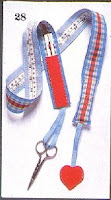These little pillows would make darling baby gifts, and would also look charming on a rocker as a back pillow, or as just another girly decoration on a bed or sofa; I plan to make a few
 more and display them on my Etsy store in the near future.
more and display them on my Etsy store in the near future.The following is a brief tutorial on how the pillow case was made with vintage fabrics that display hand embroidery, cut work and drawn-work. Pictures are shown to accompany the tutorial.
1) Decide on the picture you would like to transfer for embroidery purposes. Make sure the lines are as simple as your embroidery skills allow. (In this case, a fairy was used, but some child might like a brightly colored green frog on his pillow with contrasting bright colors.) Complete the tinting and embroidering of the chosen image.

2) Gather materials of small travel pillow (available at discount stores for under $4), vintage fabrics such as old table cloths, napkins, handkerchiefs, etc., threads and sewing equipment; lace seam binding or ribbons (optional), measuring tape and scissors;
3) The finished pillow (below) showcases two different fabrics laid on top of one another. In this case, a regular sized peach colored pillow case with a drawn-work interior was used for the under fabric; the outer edging of the existing case was turned inward and sewn down to further emphasize the previous vintage drawn-work. For the over fabric (white), a large tablecloth was cut into appropriate sizes to show off as much as possible of the lovely vintage needlework;
4) Cut both the under fabric and the over fabric the size to fit the purchased travel pillow, with a little less than one inch seam allowance added. Usual dimensions on these travel pillows are 15” x 20”, so cut the existing fabrics to allow for generous seam allowances, i.e., 31.5" x 41.5". (French seams create a more polished effect in its final appearance, so extra material for each seam was taken into account before cutting.) Hint: the under fabric should be of a contrasting color to enhance the cut-work shown on the vintage top fabric (in this case, a vintage peach pillow case was used for the under fabric);

5) You will likely need to piece together various parts of the vintage cloths in order to take the best advantage of the prior threadwork. I used lace seam binding to join two pieces of a tablecloth together to emphasize more of the cut work. Hint: ensure that the back of the pillow also incorporates as much as possible of the embroidery displayed on the vintage cloth.
6) Join the seams (french seaming, if possible) and complete the pillow case with simple straight stitching. An excellent tutorial on how to make french seams can be found here.
The finished pillow case with purchased travel pillow inside:

 (front view of the pillow case above, and back view at upper right)
(front view of the pillow case above, and back view at upper right)More information about vintage fabrics can be garnered here. A reliable seller for vintage fabrics can be found here.



 Pictured above is the face of a Roaring 20's woman that will be one of the pockets to be added to the apron front. You can read about how this vintage pocket was hand colored with crayons and watercolor pencils and coordinating embroidery,
Pictured above is the face of a Roaring 20's woman that will be one of the pockets to be added to the apron front. You can read about how this vintage pocket was hand colored with crayons and watercolor pencils and coordinating embroidery, 











